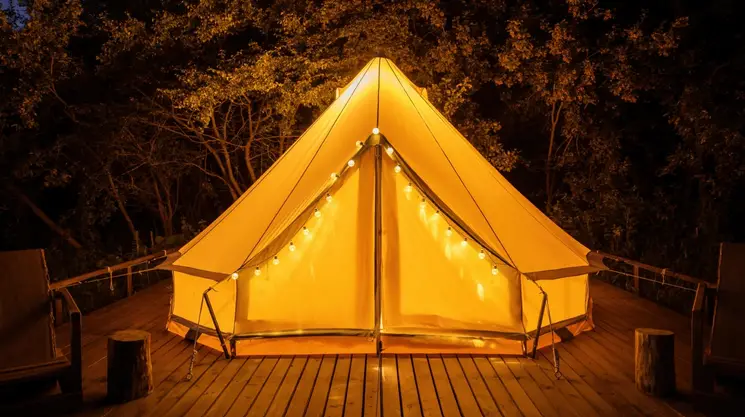This blog post may contain affiliate links. As an Amazon Associate I earn from qualifying purchases.
Bell tents are a unique and charming style of tent that has captured the imagination of camping enthusiasts and outdoor adventurers like myself. Their distinctive bell-like or conical shape, typically supported by a central pole and guy ropes, sets them apart from other tent designs. In this comprehensive guide, I’ll delve into the world of bell tents, exploring their design, practicality, and their myriad uses for camping, glamping, and special events.
The Design and Structure of Bell Tents
At first glance, the most striking feature of a bell tent is its recognizable, bell-like shape. This iconic design is responsible for the name and forms the foundation of the tent’s structural integrity. Unlike traditional A-frame tents with their rigid and angular frames, the gently sloping walls of a bell tent offer a refreshing departure.
- Materials and Construction
The primary material of choice for bell tents is often canvas. Thick, durable, and weather-resistant, canvas offers excellent protection from the elements. This robust fabric ensures that bell tents stand up to the rigors of outdoor life.
The choice of canvas over synthetic materials, such as polyester or nylon, not only provides durability but also allows for greater breathability. Canvas naturally breathes, preventing the buildup of condensation within the tent and maintaining a comfortable climate inside. This is particularly valuable in changing weather conditions, as it helps regulate temperature and humidity.
The use of heavy-duty zippers and robust stitching in the tent’s seams reinforces its sturdiness. Additionally, many bell tents are equipped with reinforced corners and tensioning straps that contribute to the tent’s overall stability.
- Stability and Adaptability
The combination of the bell shape and high-quality materials results in a tent that excels in stability. The tent’s unique shape sheds wind effectively, reducing the impact of gusts and ensuring that the structure remains upright and secure. This stability is a significant advantage, especially when camping in exposed or windy areas.
Bell tents are also highly adaptable. Their design provides ample headroom and living space, making them ideal for family camping trips, group getaways, and extended stays in the wilderness. The center pole supports the structure, eliminating the need for complex frame systems. This simplicity in design not only makes assembly straightforward but also maximizes the usable floor space within the tent.
Setting Up a Bell Tent
Setting up a bell tent can be surprisingly straightforward, especially with the right guidance. In this section, I’ll provide a detailed step-by-step guide which details how I assemble my bell tent, ensuring it stands strong in any outdoor environment.
How I Clean My Bell Tent
Ensuring the longevity of my bell tent requires a combination of proper maintenance and thoughtful care. By implementing the following practices, I can extend the life of my tent and keep it in optimal condition.
1. Regular Dusting
I’ll start with simple maintenance by regularly dusting off the tent. I’ll use a broom or a soft brush to remove dirt, dust, and debris from both the interior and exterior.
2. Spot Cleaning
For small stains, I can use a mild soap or a specialized tent cleaner. I’ll gently spot clean the affected areas using a soft sponge or cloth. I’ll avoid harsh chemicals, as they can damage the canvas.
3. Deep Cleaning
Over time, my bell tent may require a more thorough cleaning. I’ll set up the tent and hose it down with water. I’ll use a mild detergent and a soft brush to clean the canvas, working in a circular motion. I then rinse thoroughly to remove any soap residue.
4. Drying
After cleaning, I’ll ensure my bell tent is completely dry before storing it. Mildew and mold can develop in damp conditions, so I’ll let the tent air out in the sun, if possible.
How To Store My Bell Tent
Storing your bell correctly can reduce the chance of it getting damaged or developing mold. Follow these instructions to prolong the life of your bell tent.
1. Proper Folding
When it’s time to put my tent away, I fold it neatly and avoid making sharp creases, as this can weaken the fabric over time. I then roll the tent tightly to minimize bulk.
2. Dry Storage
I store my bell tent in a dry and cool place. I avoid damp or humid environments, as moisture can encourage the growth of mold and mildew.
3. Avoid Prolonged Sunlight
While canvas is durable, prolonged exposure to direct sunlight can weaken and fade the fabric over time. I’ll store my tent out of direct sunlight when not in use.
Precautions I Take When Using My Bell Tent In Harsh Weather
By following these maintenance and care guidelines, I’ll not only extend the lifespan of my bell tent but also ensure that it remains a reliable and inviting shelter for my outdoor adventures, no matter the weather or the season. Proper care will preserve its charm and functionality for years to come.
Rain and Waterproofing
Bell tents are typically made of canvas, which is naturally water-resistant to some extent. However, to enhance waterproofing, I can apply a specialized tent seam sealer to the seams and use a tent-specific waterproof spray on the exterior. This should be done annually or as needed.
Ventilation
Proper ventilation is essential to prevent condensation inside the tent. I’ll leave windows or vents open to promote air circulation, particularly in humid conditions.
Stormy Weather
In the event of severe weather, like heavy rain or strong winds, it’s essential to secure my bell tent even more firmly. I’ll check the guy ropes and stakes to ensure they are properly tensioned. Some bell tents come with storm straps, which can further bolster stability in adverse conditions.
Winter Camping
If I plan to use my bell tent in winter, I’ll consider using a stove with the proper stove jack to maintain warmth. I’ll ensure my tent is well-anchored to withstand snow accumulation and regularly clear snow from the roof to prevent overloading.
How To Choose the Right Bell Tent
Selecting the ideal bell tent is a crucial decision that can significantly impact my camping or outdoor experience. With a myriad of options available, it’s essential to consider various factors, such as size, style, and budget. In this section, I’ll show you the decision-making process and offer recommendations for reputable bell tent brands.
Size Matters
Capacity
I’ll begin by determining the number of occupants I plan to accommodate. Bell tents come in various sizes, ranging from cozy two-person tents to spacious options suitable for families or larger groups.
Comfort and Space
I’ll consider my camping style. If I prefer extra room for furnishings or have specific space requirements, I’ll opt for a tent with generous dimensions. Adequate space allows me to create a comfortable living area, even on extended camping trips.
Style and Features
Classic vs. Modern
Bell tents come in both classic and modern designs. Traditional bell tents often feature a timeless look with natural canvas, while modern versions may offer additional features like windows, stove jacks, and zippered doors. I’ll select a style that suits my aesthetic preferences and practical needs.
Seasonal Use
I’ll think about the seasons in which I plan to use my bell tent. Some are designed for fair-weather camping, while others are four-season tents built to withstand harsh winter conditions. I’ll choose accordingly.
Accessories
I’ll consider additional features and accessories that may enhance my camping experience, such as ground cloths, inner tents for added privacy, and specialized flooring options.
Budget Considerations
Entry-Level vs. Premium
Bell tents are available in a wide price range, from budget-friendly to high-end options. While premium tents often offer superior durability and features, entry-level models can provide excellent value for occasional campers.
Long-Term Investment
I’ll keep in mind that a higher upfront cost may translate into a more durable tent that serves me well for years. If I’m a frequent camper, it’s worth considering a long-term investment.
Reputable Brands
When it comes to choosing a bell tent, quality and reputation matter. I often look to the following brands:
CanvasCamp
Known for their classic and durable canvas bell tents, CanvasCamp offers a range of sizes and styles for various needs.
Lotus Belle
This brand combines modern design with quality materials to create unique and stylish bell tents, often used for glamping.
White Duck Outdoors
White Duck Outdoors produces sturdy canvas tents designed for a range of outdoor adventures, from forest camping to festivals.
Tentipi
If I’m looking for robust, four-season tents, Tentipi specializes in Nordic tipi-style tents known for their durability and versatility.
Final Thoughts – Pick The Right Bell Tent For Camping
Choosing the right bell tent involves a thoughtful consideration of factors like size, style, budget, and brand reputation. By carefully evaluating your needs and preferences, you can find the perfect bell tent that will provide you with comfort and enjoyment during your outdoor escapades for years to come.
FAQs
What are the benefits of choosing a bell tent for camping?
Bell tents provide a spacious, comfortable, and stylish alternative to traditional tents. With ample headroom and usable floor space, they’re perfect for family camping, group trips, and glamping experiences. Their sturdy canvas construction is durable, naturally breathable, and weather-resistant, offering comfort and protection in various conditions.
How do I set up a bell tent?
Setting up a bell tent is straightforward with the right steps. First, select a level campsite, unpack and organize components, erect the central pole, drape the canvas, secure the base with stakes, and adjust the guy ropes for stability. With practice, setup can be quick and efficient.
How should I care for and maintain my bell tent?
Regular maintenance ensures the longevity of your bell tent. Dust it off frequently, spot clean stains with mild soap, and do a full deep clean occasionally. Always dry the tent thoroughly before storing it in a cool, dry place to prevent mold or mildew buildup, which can damage the canvas.
What should I consider when buying a bell tent?
When choosing a bell tent, consider its size, style, seasonality, and budget. Assess how many people it will accommodate, whether you prefer classic or modern features, and the durability needed for different weather conditions. Reputable brands like CanvasCamp and White Duck Outdoors offer a range of options to suit different preferences and needs.


